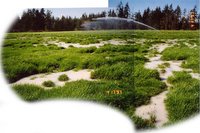Indicator of Reduction in Soils (IRIS)
Pedology and Wetland Soils
Dept. of Agronomy, Purdue Univ., Lilly Hall of Life Sciences, 915 W. State St., West Lafayette, IN 47907-2054
* Corresponding author (dfranzme@purdue.edu )
Soil drainage conditions are important to land use decisions. Traditionally, anaerobic conditions induced by poor drainage have been evaluated by observing soil color related to Fe and Mn oxides, using ,
-dipyridyl dye, measuring dissolved O2, and measuring EH. We believe that there is further need for a device that is scientifically sound and easy to use. Therefore, our goals were to develop and test a device that mimics natural soil processes, visually indicates soil reduction, and is robust. Our concept was to coat a rod or tube with a colored soil mineral that dissolves on reduction, insert the device into a soil, remove it after a few weeks or longer, and observe if some of the coating had been lost. If the coating was not dissolved, no reduction occurred, but if it was dissolved, reducing conditions must have prevailed. After trying several kinds of coatings and tubes, we chose ferrihydrite (FH) coating on polyvinyl chloride (PVC) pipe. We call the device an Indicator of Reduction in Soils (IRIS). As the study progressed we added semi-quantitative interpretations by measuring depleted areas using a digital camera and image analysis. We tested IRIS tubes in the lab and in soils in Indiana, Minnesota, and North Dakota, and concluded they performed as expected. Reduction rates increased between February and April and were related to increasing soil temperature, turnover (flux) of soil OC, and content (inventory) of OC. Reduction rates decreased after April, presumably because the nutrient supply for microbes decreased.
Abbreviations: Ac, area of FH coating in contact with the soil • Ad, area from which some FH had been depleted • D, percentage of Ac from which some FH had been depleted • DO, dissolved O2 concentration • FH, ferrihydrite • IRIS, indicator(s) of reduction in soils • OC, organic carbon • PVC, polyvinyl chloride • UDD, upper depth of FH depletion
Easy and straightforward. Kind of like the traditional sticking of the toothpick into the banana bread to see if it's done.
Note: I updated this article a few hours after posting the original. If you read the first version, my sympathies. What can I say. Its a gift.
Further Reading:
Redoximorphic Features Powerpoint presentation developed by: Michael Whited, USDA-NRCS - Wetland Science Institute August, 2000. (4.6 MB) (source page )
Technorati Tags: Soil science Wetland
